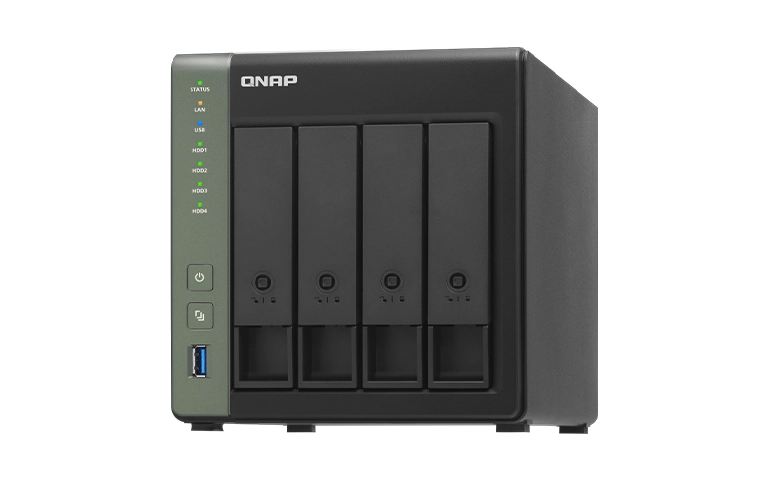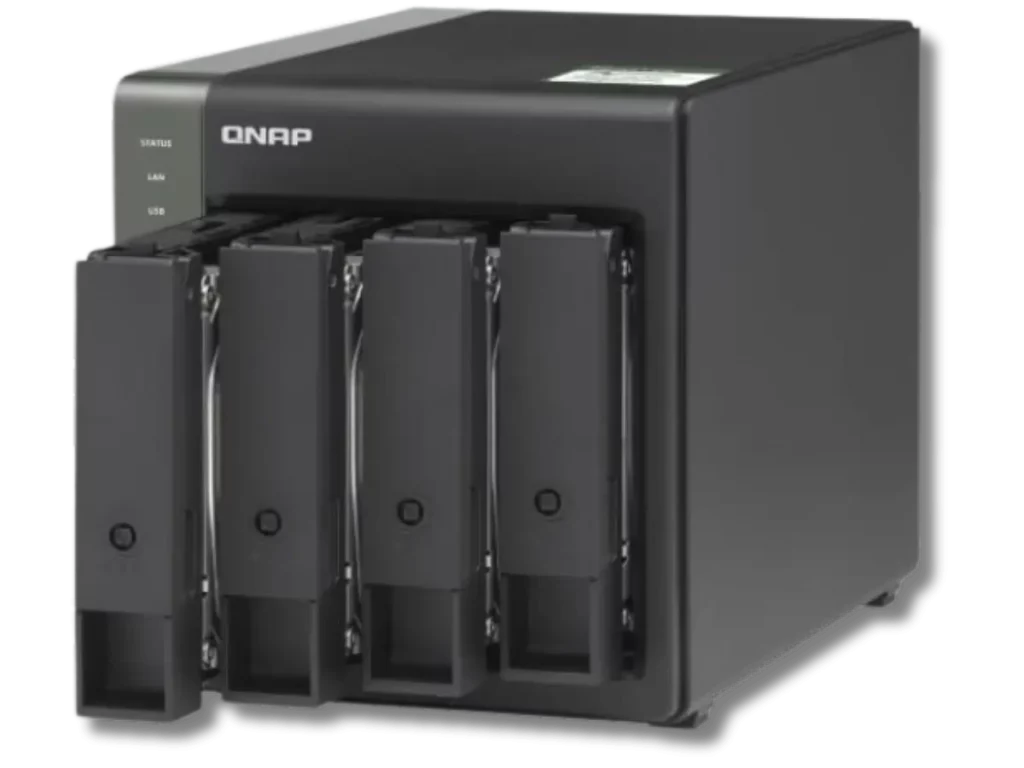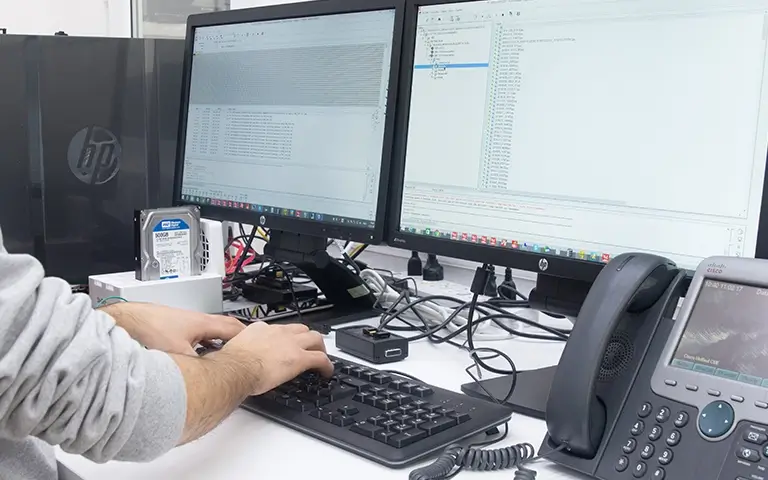A digital creator from Manhattan contacted us after encountering a serious problem with his QNAP TS-431X3 4-Bay High-Speed NAS.
The device had served as the central storage system for his YouTube production files and backup footage. For almost two years, it performed reliably and kept his creative work secure.
After being powered off for six months, the NAS began producing clicking sounds when powered back on.
Concerned, the client reviewed the system status and discovered that drives 1 and 4 had failed, resulting in the loss of a significant part of his video archive.
These files were essential for active projects, which made fast and secure data recovery an immediate priority.

Failed Drives and Early Troubleshooting Attempts
After hearing the clicking noises and noticing the failed drives, the client attempted several troubleshooting steps to recover his files.
He restarted the NAS, checked the system logs, and tried to rebuild the array using QNAP’s built-in utilities.
Despite these efforts, the NAS remained inaccessible and the drives continued to report read errors.
Like many users, he hoped that basic repair methods would restore access to his files.
However, without specialised tools, these actions could not resolve the underlying hardware faults. Realising that further attempts might cause permanent data loss, he stopped all activity and contacted RAID Recovery Services for professional assistance.
For more insight into what typically causes multi-drive NAS failures, visit Reasons for RAID Data Loss.
Device Shipment and Initial Assessment
After a detailed consultation, we provided the client with a prepaid shipping label to ensure the secure delivery of his damaged QNAP NAS to our laboratory. Once the device arrived, our engineers carried out a structured evaluation to determine the full extent of the failure.
Our standard assessment process included:
Physical inspection:
Reviewing the NAS enclosure, drive connectors, and power components for any visible signs of damage.Drive testing:
Testing all four drives individually to identify mechanical or electronic faults.Imaging procedure:
Creating bit-level copies of the drives that were still functional in order to prevent data loss during recovery.RAID structure review:
Examining parity distribution and disk order to confirm the correct RAID configuration.
The assessment confirmed that drives 1 and 4 had suffered severe physical damage, while drives 2 and 3 were partially readable.
For more information on how controller issues can affect RAID stability, read RAID Controller Failure Recovery.

Evaluation Findings and Identified Damage
During the diagnostic phase, our engineers confirmed that drives 1 and 4 had experienced significant mechanical damage.
The platters inside both drives were not spinning correctly, which explained the clicking sounds the client had noticed. Further inspection revealed deep scratches and extensive bad sectors on their magnetic surfaces, making data extraction from these two drives impossible.
Drives 2 and 3, although still functioning, contained minor bad sectors. Our team carefully imaged these drives sector by sector to preserve all readable data and transferred the images to our advanced recovery platform for detailed analysis.
The combination of multiple drive failures and sector degradation created a challenging recovery scenario. However, our engineers developed a targeted plan to reconstruct as much data as possible from the remaining healthy sectors.
To learn how physical and logical faults can affect RAID performance, visit Troubleshoot RAID Failure.
Professional QNAP Data Recovery Process
Once the evaluation was complete, our engineers began the recovery operation using a systematic, multi-step approach designed to protect data integrity from start to finish.
Steps in our recovery procedure:
Created verified clones of drives 2 and 3 so that all work could be carried out on copies and not the originals.
Used advanced read techniques to recover partially unreadable sectors as safely and accurately as possible.
Analysed QNAP RAID parameters, including stripe size and parity rotation, to rebuild the array virtually.
Retrieved and consolidated the available data from the cloned drives using specialised recovery tools.
Checked the recovered files against parity data and confirmed logical consistency throughout the reconstructed volume.
Although drives 1 and 4 could not be repaired, this controlled process allowed us to recover a substantial portion of the client’s essential video files.
For additional examples of QNAP array reconstruction, visit QNAP RAID5 MDADM Failure Recovery and How to Repair Degraded RAID.

Results and Client Verification
After completing the data reconstruction process, our team successfully restored the majority of the client’s video library.
The recovered files retained their original folder structure and naming convention, which allowed the creator to continue his projects without any disruption.
To confirm the results, we organised a remote verification session through our secure server.
During the session, the client viewed his restored files and confirmed that all essential videos were intact and fully playable. The successful recovery brought complete peace of mind and enabled him to continue producing content for his YouTube channel without losing months of work.
Once verification was complete, the device was carefully repackaged and returned to the client with detailed handling instructions to help prevent future data risks.
Fast turnaround times for business-critical data
Why Choose Professional QNAP NAS Recovery
Recovering data from a failed QNAP NAS requires precision, experience, and specialised equipment.
Using do-it-yourself recovery methods or repeatedly rebooting the device can increase physical damage and reduce the likelihood of a successful outcome.
Key reasons to rely on professional QNAP recovery services:
Safe handling of failed drives:
Engineers work in controlled environments and use certified clean benches to prevent contamination and further damage.Advanced imaging technology:
Specialised hardware tools allow safe recovery from drives that contain bad sectors or have unstable read heads.Accurate RAID reconstruction:
Professionals analyse parity rotation, disk order, and block mapping to rebuild the array correctly.Comprehensive verification:
Every recovered file is checked for consistency before delivery to guarantee data integrity.
Choosing qualified specialists gives you the highest chance of a successful recovery, especially when dealing with multi-drive NAS systems. To learn why RAID arrays should never be treated as backups, visit RAID Is Not Backup.

Restoring Your QNAP NAS Data Safely
At RAID Recovery Services, we understand that your NAS device stores valuable files that support your business, creative projects, and day-to-day operations.
Our engineers specialise in recovering data from failed QNAP systems, using proven methods that prioritise both safety and accuracy.
Whether your NAS has failed drives, corrupted RAID structures, or unreadable file systems, our team can restore your data securely.
We handle every case with care and ensure that both your device and your information remain protected throughout the recovery process.
If your QNAP NAS begins making unusual sounds or stops responding, disconnect it immediately and contact our specialists. Our experts are ready to assess your situation and guide you through each stage of the NAS data recovery process.
Trust the experts with proven results
Frequently Asked Questions
What causes multiple drives to fail in a QNAP TS-431X3 NAS?
Multiple drive failures can result from long periods of inactivity, power fluctuations, or ageing hardware. Drives that sit unused for months may seize or develop bad sectors, which can lead to data inaccessibility when the NAS is powered on again.
Can I fix a QNAP NAS that makes clicking sounds?
Clicking sounds usually indicate mechanical damage to the drive heads or platters. Restarting, rebuilding, or reinitialising the NAS can make the situation worse. The safest option is to power the device off and contact professional recovery engineers immediately.
How do professionals recover data from a QNAP NAS?
Specialists clone each drive, rebuild the RAID configuration virtually, and then extract the data from the cloned images. This controlled approach protects the original disks and ensures maximum data safety during the recovery process.
How long does a QNAP NAS data recovery take?
Timeframes depend on the number of failed drives, the severity of the damage, and the overall array size. In most cases, evaluation and QNAP TS-431X3 data recovery can be completed within a few business days.